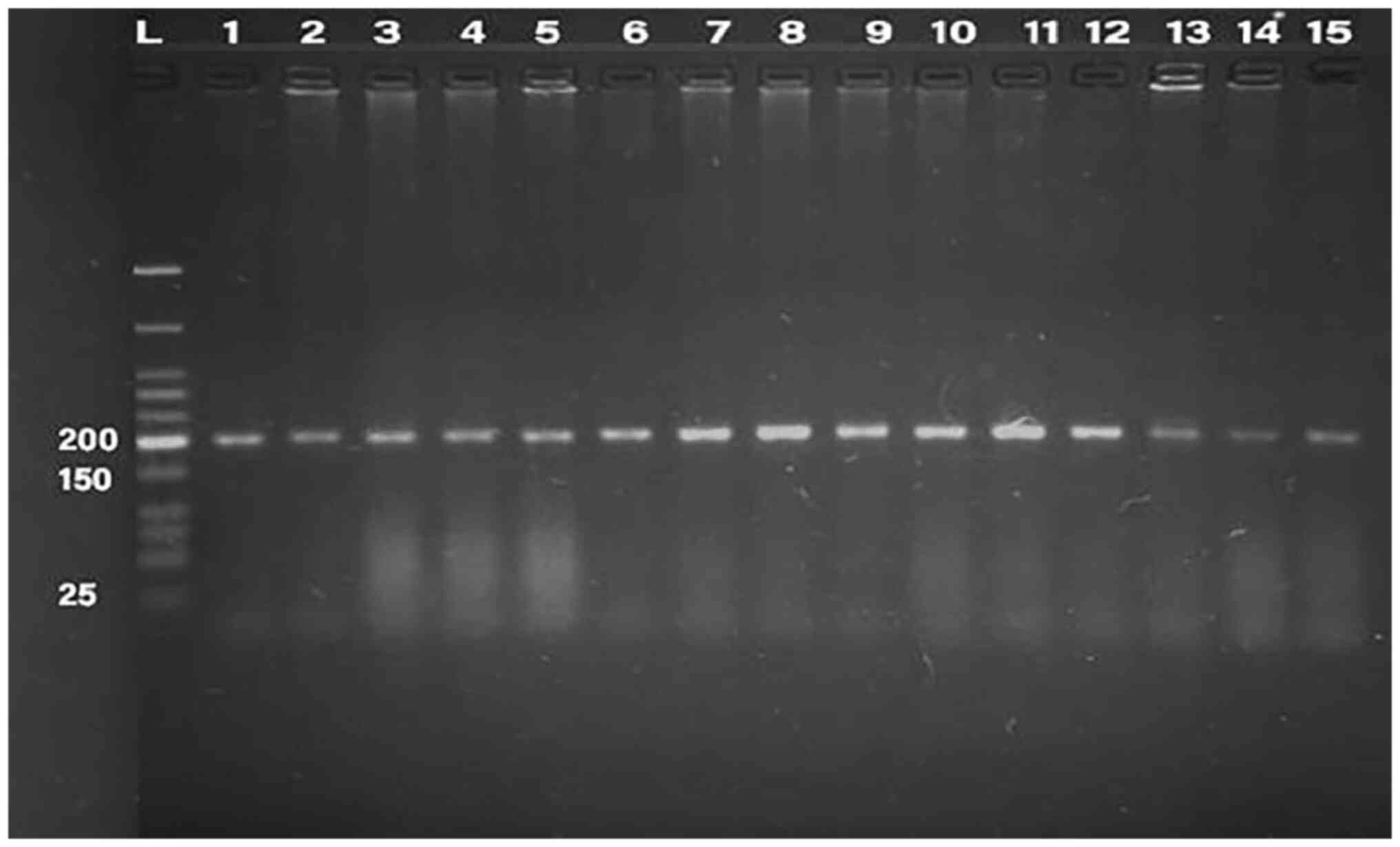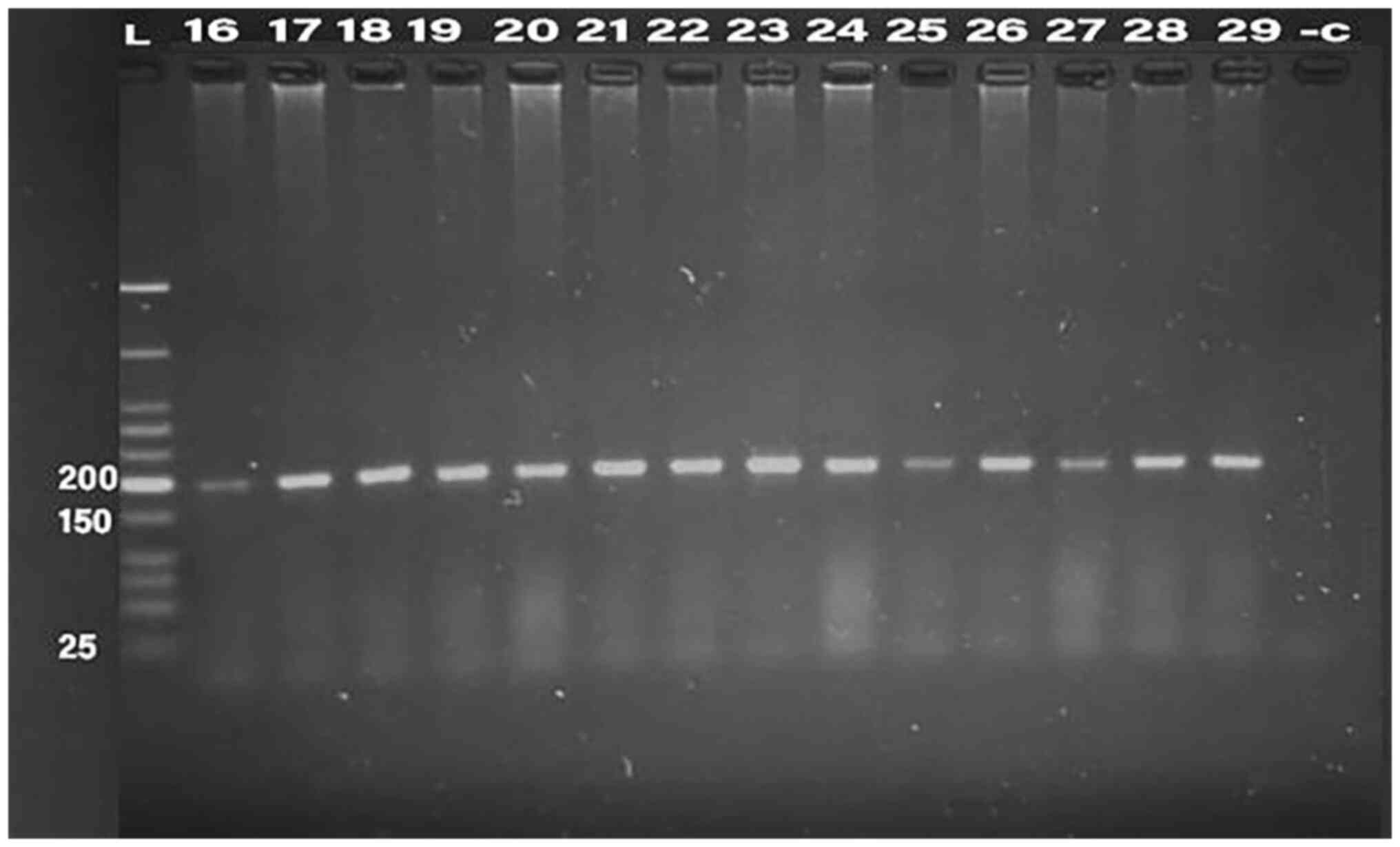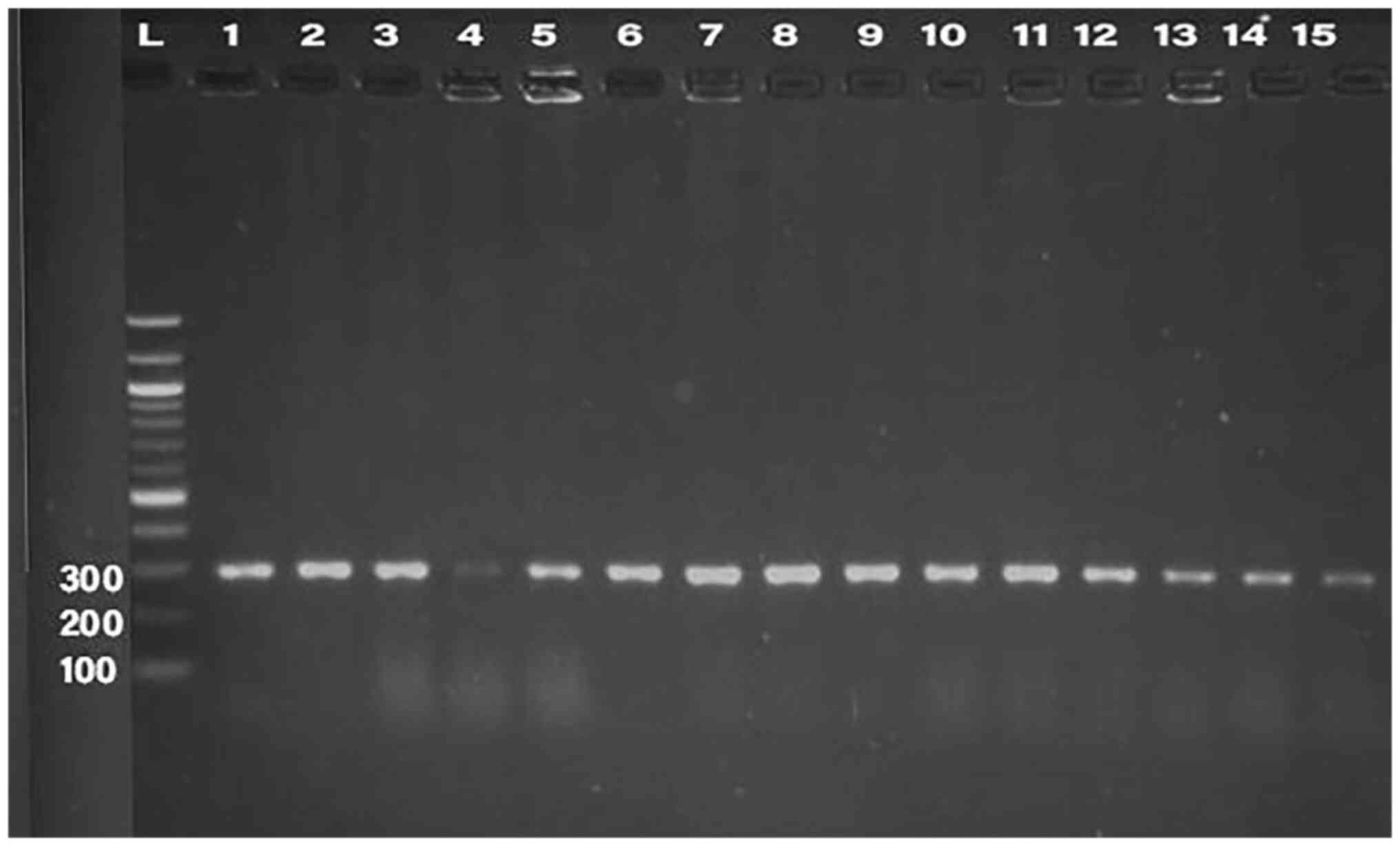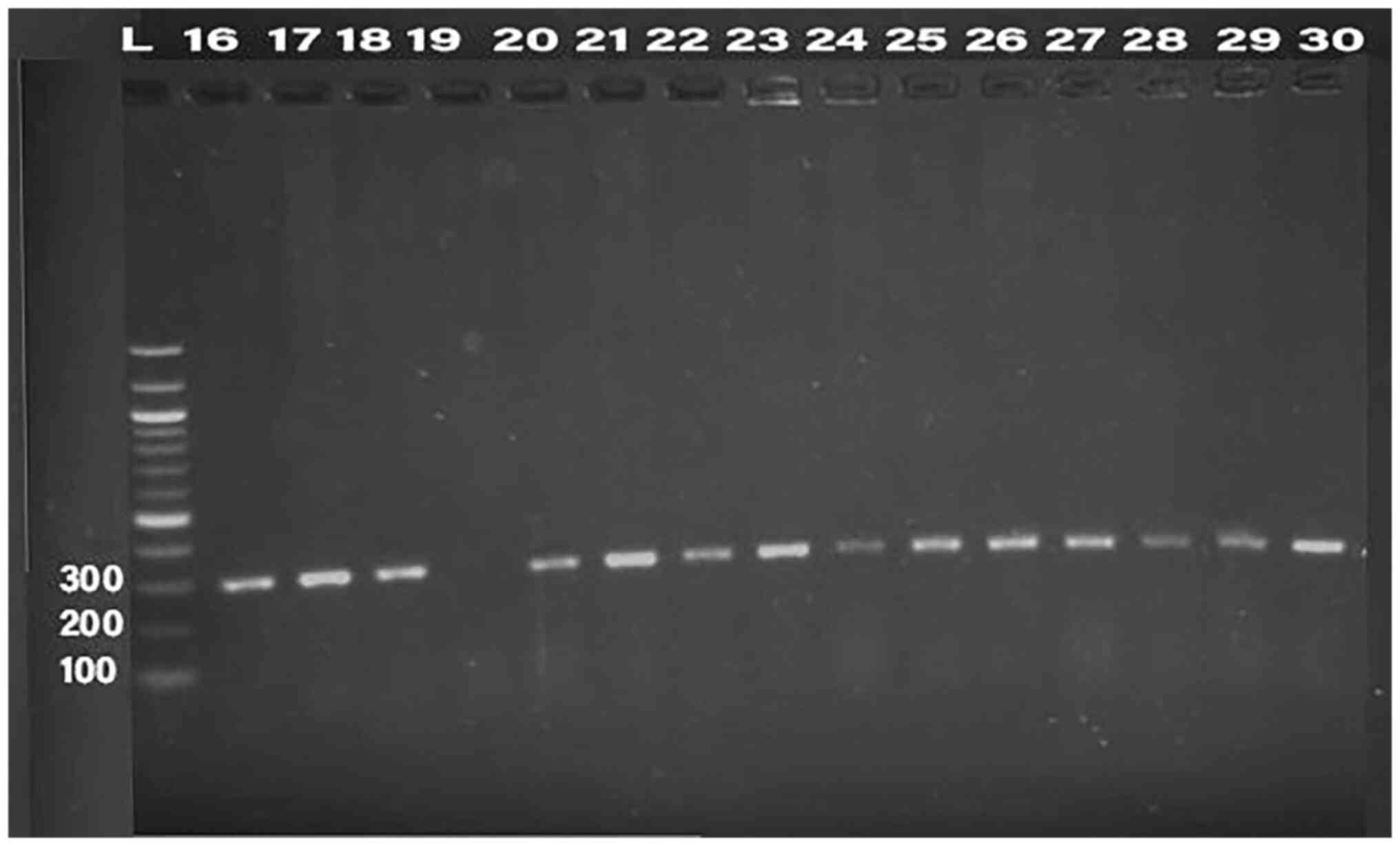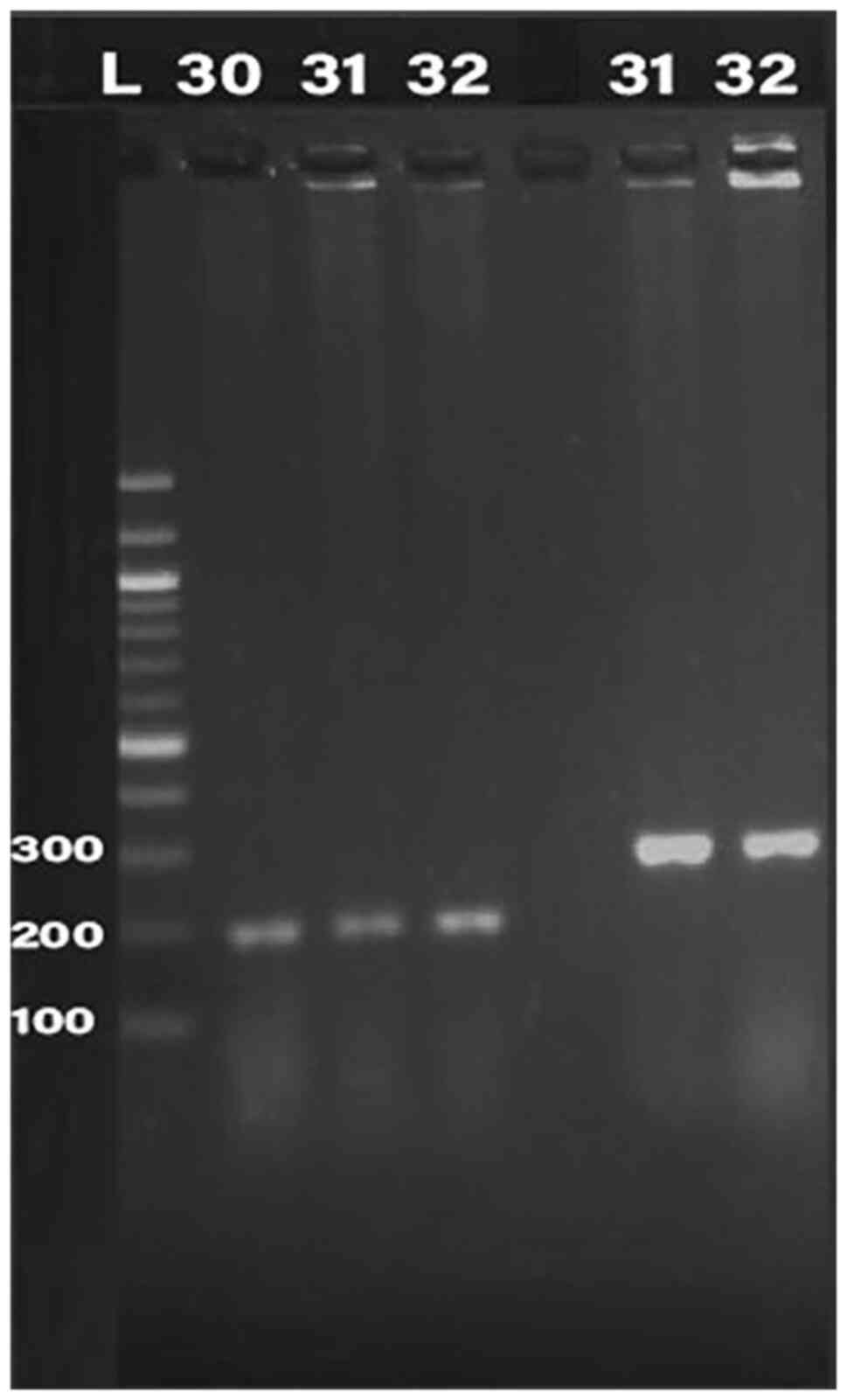|
1
|
Hoiby N, Ciofu O, Johansen HK, Song ZJ,
Moser C, Jensen PO, Molin S, Givskov M, Tolker-Nielsen T and
Bjarnsholt T: The clinical impact of bacterial biofilms. Int J Oral
Sci. 3:55–65. 2011.PubMed/NCBI View Article : Google Scholar
|
|
2
|
Stoodley P and Hall-Stoodley L: Evolving
concepts in biofilm infections. Cell Microbiol. 11:1034–1043.
2009.PubMed/NCBI View Article : Google Scholar
|
|
3
|
Donlan RM and Costerton JW: Biofilms:
Survival mechanisms of clinically relevant microorganisms. Clin
Microbiol Rev. 15:167–193. 2002.PubMed/NCBI View Article : Google Scholar
|
|
4
|
Mah TFC and O'Toole GA: Mechanisms of
biofilm resistance to antimicrobial agents. Trends Microbiol.
9:34–39. 2011.PubMed/NCBI View Article : Google Scholar
|
|
5
|
Davies J: Origins and evolution of
antibiotic resistance. Microbiologia. 12:9–16. 2010.PubMed/NCBI View Article : Google Scholar
|
|
6
|
Harrell JE, Hahn MM, D'Souza SJ, Vasicek
EM, Sandala JL, Gunn JS and McLachlan JB: Salmonella Biofilm
formation, chronic infection, and immunity within the intestine and
Hepatobiliary Tract. Front Cell Infect Microbiol.
10(624622)2021.PubMed/NCBI View Article : Google Scholar
|
|
7
|
Lojewska E and Sakowicz T: An alternative
to antibiotics: Selected methods to combat zoonotic foodborne
bacterial infections. Curr Microbiol. 78:4037–4049. 2021.PubMed/NCBI View Article : Google Scholar
|
|
8
|
Parret AH and De Mot R: Bacteria killing
their own kind: Novel bacteriocins of pseudomonas and other
gamma-proteobacteria. Trends Microbiol. 10:107–112. 2002.PubMed/NCBI View Article : Google Scholar
|
|
9
|
Denkovskiene E, Paškevičius S, Misiūnas A,
Stočkūnaitė B, Starkevič U, Vitkauskiene A, Hahn-Löbmann S, Schulz
S, Giritch A, Gleba Y and Ražanskienė A: Broad and efficient
control of klebsiella pathogens by peptidoglycan-degrading and
pore-forming bacteriocins klebicins. Sci Rep.
9(15422)2019.PubMed/NCBI View Article : Google Scholar
|
|
10
|
Grinter R, Milner J and Walker D:
Ferredoxin containing bacteriocins suggest a novel mechanism of
iron uptake in Pectobacterium spp. PLoS One.
7(e33033)2012.PubMed/NCBI View Article : Google Scholar
|
|
11
|
Hardgree M and Tu A (eds): Bacterial
Toxins: Handbook of Natural Toxins. CRC Press, Boca Raton, FL,
p488, 1988.
|
|
12
|
Thomas X, Destoumieux-Garzon D, Peduzzi J,
Afonso C, Blond A, Birlirakis N, Goulard C, Dubost L, Thai R, Tabet
JC and Rebuffat S: Siderophore Peptide, a new type of
post-translationally modified antibacterial peptide with potent
activity. J Biol Chem. 279:28233–28242. 2004.PubMed/NCBI View Article : Google Scholar
|
|
13
|
Cascales E, Buchanan S, Duché D,
Kleanthous C, Lloubès R, Postle K, Riley M, Slatin S and Cavard D:
Colicin biology. Microbiol Mol Biol Rev. 71:158–229.
2007.PubMed/NCBI View Article : Google Scholar
|
|
14
|
Maresz-Babczyszyn J, Durlakowa I,
Lachowicz Z and Hamon Y: Characteristics of bacteriocins produced
by Klebsiella bacilli. Arch Immunol Ther Exp (Warsz). 15:530–539.
1967.PubMed/NCBI
|
|
15
|
Albesa I, Finola MS, Moyano S, Frigerio CI
and Eraso AJ: Klebocin activity of Klebsiella strains and its
heterologous effect on Staphylococcus sp. Microbiologica. 12:35–41.
1989.PubMed/NCBI
|
|
16
|
Vandeppitte J, Verhaegen J, Engbaek K,
Rohner P, Piot P and Heuck C: Basic Laboratory Procedures in
Clinical Bacteriology (2nd edition). World Health Organization,
Geneva, 2003.
|
|
17
|
Clinical and Laboratory Standards
Institute (CLSI). Performance Standards for Antimicrobial
Susceptibility Testing. 33rd edition. CLSI document
M100, 2023.
|
|
18
|
Girlich D, Poirel L and Nordmann P: CTX-M
expression and selection of ertapenem resistance in Klebsiella
pneumoniae and Escherichia coli. Antimicrob Agents Chemother.
53:832–834. 2009.PubMed/NCBI View Article : Google Scholar
|
|
19
|
Herschman HR and Helinski DR: Purification
and characterization of colicin E2 and colicin E3. J Biol Chem.
212:5360–5368. 1967.PubMed/NCBI
|
|
20
|
Bradford MM: A dye binding assay for
protein. Anal Biochem. 72:248–254. 1976.
|
|
21
|
The CH, Nazni WA, Nurulhusna AH, Norazah A
and Lee HL: Determination of antibacterial activity and minimum
inhibitory concentration of larval extract of fly via
resazurinbased turbidometric assay. BMC Microbiol. 17:1–8.
2017.PubMed/NCBI View Article : Google Scholar
|
|
22
|
Jaffar N, Miyazaki T and Maeda T: Biofilm
formation of periodontal pathogens on hydroxyapatite surfaces:
Implications for periodontium damage. J Biomed Mater Res A.
104:2873–2880. 2016.PubMed/NCBI View Article : Google Scholar
|
|
23
|
Zhao T and Liu Y: N-acetylcysteine inhibit
biofilms produced by Pseudomonas aeruginosa. BMC Microbiol.
10(140)2010.PubMed/NCBI View Article : Google Scholar
|
|
24
|
Selim SA, Adam ME, Hassan SM and Albalawi
AR: Chemical composition, antimicrobial and antibiofilm activity of
the essential oil and methanol extract of the Mediterranean cypress
(Cupressus sempervirens L.). BMC Complement Altern Med.
14(179)2014.PubMed/NCBI View Article : Google Scholar
|
|
25
|
Mathur S, Gutte M, Paul D and Udgire M:
Study the effect of essential oils on microbial biofilm formation
by Klebsiella pneumoniae. Sch Acad J Biosci. 1:76–79. 2013.
|
|
26
|
Anderson C, Johnson TR, Case CL,
Cappuccino JG and Sherman N: Great Adventures in the Microbiology
Laboratory. 7th edition. pp175-176, 2013.
|
|
27
|
Orden B and Franco A: Wellcolex colour
salmonella test and Selenite-F broth. J Clin Microbiol.
31:2249–2250. 1993.PubMed/NCBI View Article : Google Scholar
|
|
28
|
Peruzy MF, Capuano F, Proroga YTR,
Cristiano D, Carullo MR and Murru N: Antimicrobial susceptibility
testing for salmonella serovars isolated from food samples:
Five-year monitoring (2015-2019). Antibiotics (Basel).
9(365)2020.PubMed/NCBI View Article : Google Scholar
|
|
29
|
Veeraraghavan B, Pragasam AK, Ray P, Kapil
A, Nagaraj S, Perumal SP, Saigal K, Thomas M, Gupta M,
Rongsen-Chandola T, et al: Evaluation of antimicrobial
susceptibility profile in salmonella typhi and salmonella paratyphi
A: Presenting the current scenario in india and strategy for future
management. J Infect Dis. 224:S502–S516. 2021.PubMed/NCBI View Article : Google Scholar
|
|
30
|
Patil N and Mule P: Sensitivity pattern Of
Salmonella typhi And Paratyphi A isolates to chloramphenicol and
other anti-typhoid drugs: An in vitro study. Infect Drug Resist.
12:3217–3225. 2019.PubMed/NCBI View Article : Google Scholar
|
|
31
|
Kareem AA, Al-Salmani TS and AlSalmani MS:
Detection of klebicin gene cluster from klebsiella pneumoniae
isolated from sputum at baghdad city. Indian J Public Health Res
Develop. 10:4970–4973. 2019.
|
|
32
|
Yang SC, Lin CH, Sung CT and Fang JY:
Antibacterial activities of bacteriocins: application in foods and
pharmaceuticals. Front Microbiol. 5(241)2014.PubMed/NCBI View Article : Google Scholar
|
|
33
|
Lloubès R, Cascales E, Walburger A,
Bouveret E, Lazdunski C, Bernadac A and Journet L: The Tol-Pal
proteins of Escherichia coli cell envelope: An energized system
required for outer membrane integrity. Res Microbiol. 152:523–529.
2001.PubMed/NCBI View Article : Google Scholar
|
|
34
|
Chavan M, Rafi H, Wertz J, Goldstone C and
Riley MA: Phage associated bacteriocins reveal a novel mechanism
for bacteriocin diversification in klebsiella. J Mol Evol.
60:546–556. 2005.PubMed/NCBI View Article : Google Scholar
|
|
35
|
Riley M, Pinou T, Wertz J, Tan Y and
Valletta C: Molecular characterization of the klebicin B plasmid of
Klebsiella pneumoniae. Plasmid. 45:209–221. 2001.PubMed/NCBI View Article : Google Scholar
|
|
36
|
Khalaf ZZ and Hussein AR: Antibiofilm
activity of klebocin crude extract against Some Species of
Enterobacteriaceae. Iraj J Sci. 59:1826–1835. 2018.
|
|
37
|
Michel-Briand Y and Baysse C: The Pyocins
of Pseudomonas aeruginosa. Biochimie. 84:499–510. 2002.PubMed/NCBI View Article : Google Scholar
|
|
38
|
Smith K, Martin L, Rinaldi A, Rajendran R,
Ramage G and Walker D: Activity of Pyocin S2 against Pseudomonas
aeruginosa Biofilms. Antimicrob Agents Chemother. 56:1599–1601.
2012.PubMed/NCBI View Article : Google Scholar
|
|
39
|
Al-Charrakh AH, Yousif SY and AlJanabi HS:
Antimicrobial spectrum of the action of bacteriocins from
Klebsiella isolates from Hilla/Iraq. Iran J Microbiol.
2(1)2011.
|















